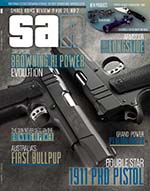Emageeman's Corner: V21N2
By Robert G. Segel
WWI Era Shoulder Patch
Very early and very rare World War I era shoulder patch for the 31st “Dixie” Division consisting of a triangle bisected with red and blue denoting a machine gun battalion with two “D”s back-to-back. This patch was very quickly changed to a white disk on which is a red circle within which are two red “D”s back-to-back. The 31st infantry Division was a unit of the Army National Guard originally established in early 1917 as the 10th Division with Alabama, Florida and Georgia national guardsmen. Later that same year, the 10th became the 31st. Trained at Camp Gordon, Georgia, the Division arrived in France in September 1918 and was designated as a replacement Division. The Division returned to the U.S. in July 1919 where the men were mustered out of service. The 31st Division was mobilized in 1940 with National Guard Divisions from Alabama, Florida, Louisiana and Mississippi.
Russian Medallion
A Russian, large, bronze-clad metal table medallion commemorating Vasily Alekseyevich Degtyarev (1880-1949). The obverse has a raised relief image of Degtyarev with the inscription, in Russian, “In Honor of the 100th Anniversary of the Birth of Vasily Alekseyevich Degtyarev 1880-1980.” The reverse inscription reads, “Russian Gunsmiths USSR,” with a central image of a DP-28 light machine gun that Degtyarev created and which was the main light machine gun of the Russian army in World War II. The medallion measures 75 mm in diameter and also has the original red plastic box/stand.
WWI Brodie Helmet
U.S. World War I Brodie helmet for a machine gun company of the 27th Infantry Regiment of the American Expeditionary Force Siberia (A.E.F. Siberia). Painted in white winter camouflage with the A.E.F. Siberia insignia painted on the front of an “S” (for Siberia) superimposed upon a standing bear within an artillery shell. On the right side of the helmet is painted “27th” over “MG.” The machine gun companies were issued Browning Model of 1917 water-cooled machine guns and Browning Automatic Rifles (BAR) Model of 1918. Nearly 8,000 men, mostly from the 27th and then the 31st Infantry Regiments, were sent to Russia during World War I after the October Revolution from 1918 to 1920 and suffered severely from the brutal Siberian winter.
They were sent to Russia to help rescue the 40,000 men of the Czechoslovak Legions being held up by Bolshevik forces as they attempted to make their way along the Trans-Siberian Railroad to Vladivostok and, hopefully, to the Western Front. Additionally, they were sent to protect the large quantities of military supplies and railroad rolling stock that the U.S. had sent to Russia in support of the war effort against Germany before the Bolshevik Revolution. They failed in their mission.
Cap and Collar Badge
South Waziristan Scouts officer’s cap and collar badge circa 1920s. The cap badge has the British king’s crown over crossed Vickers with “South Waziristan Scouts” banner below with four lugs to the rear. The collar badge has the king’s crown over a mountain goat head and two lugs to the rear. South Waziristan is the southern part of Waziristan, a mountainous region of northwest Pakistan. The region was an independent tribal territory from 1893, remaining outside of the British-ruled Empire and Afghanistan. Tribal raiding into British-ruled territory was a constant problem for the British, requiring frequent punitive expeditions between 1860 and 1945. The region became part of Pakistan in 1947.
Sweetheart Pin
A sweetheart pin for the 3rd Machine Gun Company, 1st Canadian Division has red, white and blue enamel on a brass badge, with the king’s crown to the top and a Vickers machine gun on tripod to the center. The top banner reads, “3rd M.G. Co.” and below is “1st Canadian Division.” Pin back.
Swedish Machine Gunner Badge
A Swedish 1950s-era army machine gunner’s silver metal shooting breast badge that has three Swedish crowns to the top with two crossed M45 submachine guns to the center. Pin back.
This article first appeared in Small Arms Review V21N2 (March 2017) |
| SUBSCRIBER COMMENT AREA |
Comments have not been generated for this article.









